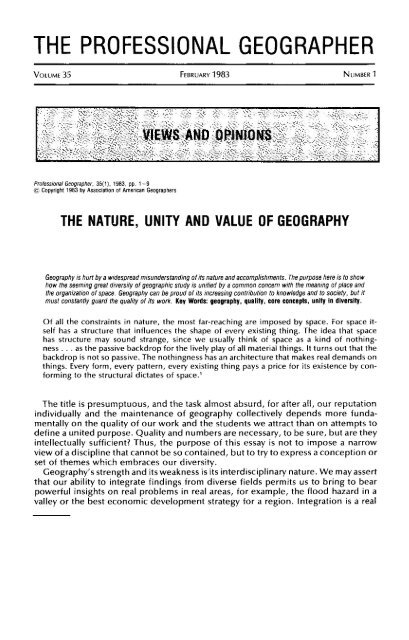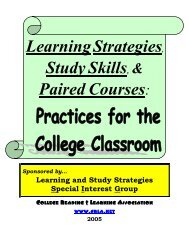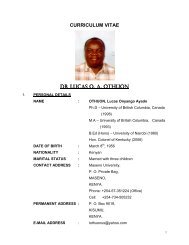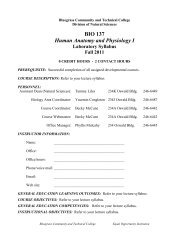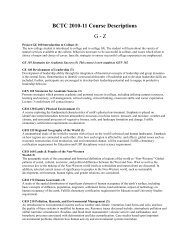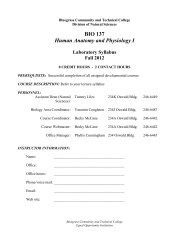THE NATURE, UNITY AND VALUE OF GEOGRAPHY
THE NATURE, UNITY AND VALUE OF GEOGRAPHY
THE NATURE, UNITY AND VALUE OF GEOGRAPHY
Create successful ePaper yourself
Turn your PDF publications into a flip-book with our unique Google optimized e-Paper software.
<strong>THE</strong> PR<strong>OF</strong>ESSIONAL GEOGRAPHER<br />
VOLUME 35 FEBRUARY 1983 NUMBER 1<br />
Proless/ona/ Geographer. 35(1), 1983, pp 1- 9<br />
@ Copyright 1983 by Association of American Geographers<br />
<strong>THE</strong> <strong>NATURE</strong>, <strong>UNITY</strong> <strong>AND</strong> <strong>VALUE</strong> <strong>OF</strong> <strong>GEOGRAPHY</strong><br />
Geography is hurt by a widespread misunderstanding of its nature and accomplishments. The purpose here is to show<br />
how the seeming great diversity of geographic study is unified by a common concern witb the meaning of pke and<br />
the organization of space. Geography can be proud of its increasing contribution to knowledge and to society, but it<br />
must constantly guard the quality of its work. Key Words: geography, quality, core concepts, unity in diversity.<br />
Of all the constraints in nature, the most far-reaching are imposed by space. For space it-<br />
self has a structure that influences the shape of every existing thing. The idea that space<br />
has structure may sound strange, since we usually think of space as a kind of nothing-<br />
ness . . . as the passive backdrop for the lively play of all material things. It turns out that the<br />
backdrop is not so passive. The nothingness has an architecture that makes real demands on<br />
things. Every form, every pattern, every existing thing pays a price for its existence by con-<br />
forming to the structural dictates of space.'<br />
The title is presumptuous, and the task almost absurd, for after all, our reputation<br />
individually and the maintenance of geography collectively depends more funda-<br />
mentally on the quality of our work and the students we attract than on attempts to<br />
define a united purpose. Quality and numbers are necessary, to be sure, but are they<br />
intellectually sufficient? Thus, the purpose of this essay is not to impose a narrow<br />
view of a discipline that cannot be so contained, but to try to express a conception or<br />
set of themes which embraces our diversity.<br />
Geography's strength and its weakness is its interdisciplinary nature. We may assert<br />
that our ability to integrate findings from diverse fields permits us to bring to bear<br />
powerful insights on real problems in real areas, for example, the flood hazard in a<br />
valley or the best economic development strategy for a region. Integration is a real
2 <strong>THE</strong> PR<strong>OF</strong>ESSIONAL GEOGRAPHER<br />
strength, but to scholars and administrators from other disciplines this czpacity may<br />
be viewed as eclectic, even parasitic, and as evidence of the lack of disciplinary<br />
focus. In an era of declining university enrollment and support of higher education<br />
and of the termination of “weak or non-central” programs, we cannot afford either<br />
to rely on the good will of competitors to recognize our good works or to carry on as<br />
usual as “undisciplined” discipline.<br />
The loss or threatened loss of geography programs or of their separate identity is<br />
not unique to our discipline, yet it serves as an obvious warning to even the<br />
strongest programs that all is not well. Geography has some real problems, but it is<br />
also making a greater contribution than ever before, and is well deserving of our best<br />
efforts to preserve and enhance this role.<br />
We would not be geographers if we did not believe in the reality and value of the<br />
discipline. But it would be foolish not to recognize that not all the outside world<br />
shares our perception. The image or understanding of modern geography is<br />
clouded, even among academics in closely-related fields. We have done little to<br />
dispel this nebulous image.<br />
in Canada and Europe, geography has a strong and popular base in the primary<br />
and secondary educational system, but in the United States, formal geography is a<br />
fragile edifice at the college-university level, without substantial roots of public<br />
awareness and support. And while our students have been remarkably successful at<br />
finding and excelling in a wide variety of jobs, beyond academia, they are too rarely<br />
identified as geographers. We must, then, make clear to the outside world just what<br />
is the nature and value of geography, why geography is essential and central to the<br />
mission of education at all levels, and why the profession or occupation of geog-<br />
raphers should become increasingly recognized.<br />
Criticisms of Geography<br />
Attacks on geography are leveled both at specific problems of particular depart-<br />
ments (lower enrollment or faculty productivity) and at the profession as a whole.<br />
While a local termination or merger may have been decided on grounds of quality,<br />
isn’t the more important reason the judgment by some administrators that geogra-<br />
phy just didn’t matter, and we weren’t strong enough to do anything about it? Here<br />
are some common complaints lodged against geography:<br />
First, that it is not central, that is, it provides no essential dimension of higher<br />
education. While geography may be viewed as interesting, it is not often perceived<br />
as essential to either liberal education or to the training of other professions.<br />
Second, that it is parasitic and eclectic; that it has no core but is a loose collection<br />
of specialties which are more logically components of many more established disci-<br />
plines. This is a serious charge which we had better be prepared to deal with. This<br />
charge is based on various kinds of evidence, for example, the seemingly incredible<br />
heterogeneity of papers at our annual meetings. The image is hardly dispelled by the<br />
curricula at some institutions where there is a geography of almost everything-like<br />
economic, social and political. The problem really becomes serious when it comes to<br />
jurisdictional disputes over courses and degrees with planning, atmospheric sci-<br />
ences, sociology or engineering. I am very much afraid that too few departments<br />
have a core course or sequence of courses which provide a strong conceptual and<br />
theoretical basis for the diversity of topical and regional courses. If we do not, how<br />
can we counter the argument that we are doing sociology, or economics or whatever<br />
under another name? Can geography really be what geographers feel like doing? The<br />
problem is not diversity as such, since other disciplines, like anthropology, have<br />
many topical and areal specializations, but there is a recognition that these all stem<br />
from common theoretical concerns.
VOL. 35, NUMBER 1, FEBRUARY, 1983<br />
Third, it is charged, geography has inadequate standards and quality, as revealed<br />
in its courses, its training of graduate students, its papers at annual meetings, and in<br />
its leading journals. All four of these aspects have been used against geography in<br />
program reviews. Geography has too often succumbed to faddish courses which<br />
may have served a temporary purpose ten years ago, but cannot withstand the<br />
scrutiny of the cost-effective 1980s. Our graduate training is, generally, quite defen-<br />
sible at many or most institutions, but it is perhaps not good enough to withstand the<br />
increasingly rough internal reviews and the heightened demands of employers.<br />
Personally, I am very concerned with what I view as a retreat from rigor in the<br />
training of many students, including the abandonment of foreign languages, carto-<br />
graphic skill requirements, and statistical methodology. The attack by well-meaning<br />
geographers on geography as a science, because it may not always be done well, is a<br />
very damaging disservice.<br />
Our annual meetings are viewed as open and sometimes exciting, but also as<br />
eclectic, with many papers of inadequate quality. AAG councils and members have<br />
had spirited debates for years on the advantages of open meetings to encourage<br />
participation and paper screening to raise quality. Our latest compromise, to require<br />
a 900 to 1200 word abstract for all papers, including those of specialty groups, may or<br />
may not help. Ultimately, the quality depends not on how we organize the meetings,<br />
but on members taking a serious responsibility for their own and their profession’s<br />
well-being.<br />
The quality of our journals is to a degree a matter of subjective interpretation.<br />
However, because issues of consistency of quality and balance were raised, the<br />
Council has established stronger oversight, through the mxhanism of editorial<br />
boards. In addition, there is the intent to differentiate the Annals and Professional<br />
Geographer, the former emphasizing scholarly research, the latter the needs of the<br />
profession: the exchange of ideas, statements of current research, and contributions<br />
of geographers in business and government. A difficult issue which may need to be<br />
considered is whether the proliferation of specialized journals adversely affects the<br />
Association pub1 ications.<br />
Fourth, it is charged, geography is non-functional, that is, it doesn’t lead to any<br />
clear occupation, except perhaps cartographer. Rather our successful competing as<br />
planners, location analysts, or regional economists can be seen as more evidence of<br />
parasitism, although we might argue that we are as good or better, and that these<br />
represent attempts to regain territory once lost to us. Still, in the longer run, the<br />
generation of a demand for geographers as such, as well as the recognition of<br />
geographic training as essential for many other occupations, will be a major goal.<br />
Meeting the Challenges<br />
Well, these are difficult problems, but we can view them as challenges to be met.<br />
There are also many things we can do right to maintain and improve the position of<br />
geography locally and nationally. The local level is probably the more important. The<br />
first broad issue of geography’s centrality in the long run depends on successfully<br />
dealing with the other problems. But in the shorter run programs can be greatly<br />
helped by visibility and participation, that is, by the aggressive involvement of faculty<br />
and students in university governance and interdisciplinary programs. Of course,<br />
public involvement cuts both ways. If we aren’t prepared, qualified and responsible,<br />
exposure can damage, especially if testimony is based on emotion instead of<br />
analysis. Such participation takes time, but it is well worth the effort through greater<br />
awareness of what we are capable of, and through the generation of internships and<br />
jobs.<br />
Establishment of local geographical societies, and the utilization of local officials
4 <strong>THE</strong> PR<strong>OF</strong>ESSIONAL GEOGRAPHER<br />
and business people in these meetings, and the use of our successful professional<br />
alumni iii the private and public sectors in our courses and seminars can also be<br />
val u ab le.<br />
The second problem of eclecticism and disunity can also be approached locally.<br />
Most departments need to review their courses carefully for titles and descriptions to<br />
determine that they, relate to key geographic concepts and also offer some fairly<br />
clear and useful knowledge or training for ourselves and others. I may well be<br />
wrong, but it is perhaps courses with titles like economic or social or political geo-<br />
graphy which lead to the charge of parasitism, whereas we are on distinctive ground<br />
if we emphasize geographic concepts like region, spatial organization, urban or rural,<br />
transportation, migration, spatial distribution, landscape and the like. Difficult as it<br />
may be, we need also to hammer out, formally if necessary, a complementary divi-<br />
sion of labor with competing programs. The object here is to create sequences of<br />
geography courses that come to be viewed as necessary and integral parts of such<br />
interdisciplinary areas as planning, transportation, population, and environmental,<br />
urban or area studies.<br />
Finally we should proudly and explicitly offer a core course or courses sum-<br />
marizing geographic theory and methodological issues, preferably as an advanced<br />
survey rather than as a history of geographic thought. Concepts like spatial organi-<br />
zation and interaction, spatial or territorial behavior, regional development and<br />
change, evolution of landscape, regions and regionalization, graphic representation,<br />
efficiency and equity in location and in resource distribution and utilization should<br />
be emphasized, because only dimensional rather than phenomenological charac-<br />
teristics can unify physical and human, regional and topical, cultural-humanist and<br />
quantitative-locational geographies. Put more simply, a core course or courses<br />
should get across the message that location matters, that there are reasons why areas<br />
and places are different physically and culturally, that knowledge of how territory is<br />
organized and changes is a key problem in science and society.<br />
With respect to quality, there should be no mystery. It is a matter, at all levels in all<br />
activities,, of maintaining more rigorous standards, and of exercising greater self-<br />
discipline in meetings and journals.<br />
With respect to the placement of professional geographers, we are at the stage<br />
where we have to risk fights by aggressively competing for relevant planning and<br />
analytical positions in the private and public sectors. This may mean putting rela-<br />
tively more emphasis on masters programs, on internships, and on the real world<br />
involvement that is necessary to generate those internships and jobs. Too, the di-<br />
versity which was noted as a possible strength is also manifest as a weakness in the<br />
structure of many of our departmental programs. There is an understandable desire<br />
for broad coverage of the discipline, but with small staffs, this means a lack of depth<br />
and an inability to insure the quality specialized training that students need and<br />
employers deserve and which will gain the respect of other disciplines.<br />
We should not be discouraged by a review of the above problems. Geography has<br />
come a long way in the last twenty-five years. Despite the precipitous decline in our<br />
historic service role to education, despite the severe competition from regional<br />
science, urban and regional planning, and area and environmental studies, both the<br />
status and funding of geography have vastly improved. If we can maintain the<br />
momentum of recent years, we will be able to achieve as well as to deserve the<br />
centrality and occupational recognition we desire.<br />
Discussing problems of a discipline is difficult enough. Now I will take a greater<br />
risk and tackle the question of the nature of the discipline, since most of the above<br />
problems trace back to the nebulous image of geography. The question legitimately<br />
can be asked: if we cannot clearly, and with reasonable agreement, express the<br />
nature of the discipline, can and do we deserve recognition?
VOL. 35, NUMBER 1, FEBRUARY, 1983 5<br />
What is Geography?<br />
What is special or unique about geography is simply that its object of analysis is the<br />
earth’s surface, and that its purpose is to understand how that surface is structured<br />
or differentiated. This purpose is best expressed through a small set of basic ques-<br />
tions.<br />
(1) What is the structure or organization of the landscape and of flows that results<br />
from physical processes; how do these transform the landscape?<br />
(2) What is the territorial structure or organization and the flows that result from<br />
social and economic processes? How do these transform the landscape?<br />
(3) What is the relation between these physical processes and human settlement,<br />
behavior and development?<br />
(4) How do the facts of spatial separation and of differential physical endowment<br />
condition the operation of social and economic processes and the character of<br />
places and regions?<br />
(5) How can spatial process and structure best be analyzed and displayed?<br />
But scholars in other disciplines often ask such questions about the phenomena or<br />
processes they study, the skeptic will reply. According to the above questions, ge-<br />
ography is certainly both a physical and a social science. What keeps the subject<br />
under meaningful limits?<br />
The justification for geography as a distinct discipline is two-fold. First, at a<br />
theoretical level, modern geography is demonstrating that fundamental principles of<br />
human-environmental interaction and spatial organization hold across broad classes<br />
of physical and human processes. The special contribution of geography is not only<br />
that our theories, models and analytical techniques enrich and improve the theory<br />
and practice of other disciplines, but also that spatial processes, behavior, and dif-<br />
ferentiation are fundamental phenomena of central scientific importance and com-<br />
prise the core of the discipline of geography.<br />
Yes, other disciplines do and have to ask these territorial questions. But it is only<br />
geography which realizes that the fact of space is not just an awkward inconvenience<br />
in our theories (economics, epidemiology, etc.) but a basic organizing principle of<br />
existence, that the landscape manifests an incredible structure of both general pat-<br />
tern and unique character that requires interdisciplinary comparison and integration<br />
to understand.<br />
Second, at a pedagogical level, geography can make a distinctive contribution in<br />
its capacity to describe and analyze how diverse physical and human processes do<br />
interact to produce particular regional landscapes, cultures and places. At an<br />
elementary level, this is often the only geography our critics remember (from the<br />
fourth grade) but at a university level, such integration can be an immensely creative<br />
and valuable contribution to international understanding and policy formation.<br />
Key Geographic Concepts<br />
The motto of the geographer might be that “location matters”: that physical and<br />
human processes are conditioned by the fact that all phenomena take up space and<br />
that the quality of locations differs inevitably and predictably; that humans must<br />
continually evaluate both the opportunities and the constraints that the characteris-<br />
tics of the surrounding environment and the separation of its elements present us. If<br />
this is a reductionist statement, and appears to exclude any who feel they are geog-<br />
raphers, I need to know so that I can work on my powers of expression. To convince<br />
the skeptic that this argument is more than rhetoric, a few examples may be useful.<br />
For convenience, 1’11 use my own work, but the geography reader can substitute<br />
others.
6 <strong>THE</strong> PR<strong>OF</strong>ESSIONAL GEOGRAPHER<br />
One ke,y concept is that territory (space) becomes efficiently divided into similar<br />
areas (“cells”) as a resolution of opposing forces: of the benefits of increasing size<br />
and the costs of maintaining ”control” over a greater distance. Withough elaborat-<br />
ing, it can be demonstrated that examples are legion across physical and human<br />
phenomeina. In some of my work, for example, I tried to trace the evolution of the<br />
placement of towns and the structure of their tributary areas in a part of Sweden, as<br />
the benefits of size came increasingly to outweigh the costs of serving their hinter-<br />
lands and as investment in transport reduced the friction of separation. In another<br />
study, I analyzed the social barriers that tended to prevent the ideal spacing and<br />
efficient utilization of Chicago area hospitals. This study also illustrated a second<br />
principle conditioning territorial organization, viz., the tension between an efficient<br />
structure which serves the greatest number at the least cost, and a social concern for<br />
equity of access so that none should be too badly off.<br />
Another key concept is that the character of the landscape can change gradually<br />
over space and over time as a consequence of two other opposing forces. On the<br />
one hand, separation, to the point of isolation, in particular environments over long<br />
periods m8ust be the basic explanation for the extraordinary diversity in nature and<br />
culture. But on the other hand, the equally powerful forces of interaction across<br />
space, through both physical and human processes that are hindered by space itself,<br />
diffuse and modify that diversity. Those same forces spread the more successful at<br />
the expense of the less successful phenomena or culture traits. In the same Swedish<br />
study, I also explored how investment in transportation and in cities diffused across<br />
the area from earlier developed centers, and how both the fact of space and the<br />
differential character of subareas conditioned the pattern of change. In another<br />
study of an epidemic, I also illustrated the diffusion of a phenomenon, smallpox,<br />
through a population and across a territory in which variable clustering or isolation<br />
of families predictably govern the spread of the epidemic.<br />
A fourth key concept is the differential need for and ability of activities to compete<br />
for access to a central point, and a fifth considers the need or preference for ac-<br />
tivities and people to be close together or apart. The most obvious manifestation of<br />
these spai.ial principles is the geographic structure of the city, patterns of land use<br />
and social space that result from competition and social compatibility principles<br />
which underlie my work on racial ghettoes.<br />
Finally, I will invoke the geographic concept of region. Regions may be defined as<br />
the territories which result from the playing out of physical and human processes in<br />
the landscape. They are the manifest taxonomy of geography, the empirical, interre-<br />
lated coniposites of phenomena which geographers, as both scientists and<br />
humanists, strive to explain and understand. In recent years, I have extensively<br />
studied the political region, including electoral districts. I would simply mention<br />
here only one important contribution I hope geographers can make: that electoral<br />
districts need not and should not be mere temporary conveniences for the carrying<br />
out of elections, but to the extent possible be meaningful communities of interest<br />
that enhaiice voter identification and participation and representative responsive-<br />
ness.<br />
Governments and businesses are continually required to delimit and utilize re-<br />
gions, but most people’s ignorance of the geography, or the organization of the<br />
landscape, at any scale results in serious mismatches of purpose and function. One<br />
of the major and continuing contributions of the geographer can be to find the<br />
region appropriate to a problem for the analysis of impacts, for the implementation<br />
of laws.<br />
I have argued that space-in the geometric sense of separation and relative loca-<br />
tion, in the environmental sense of the differential physical characteristics of areas<br />
and also in the humanistic sense of the unique identity of places-is the core of
VOL. 35, NUMBER 1, FEBRUARY, 1983 7<br />
geography. It follows that the map, and cartography, are absolutely fundamental<br />
parts of the discipline, not only in depicting geographically distributional patterns,<br />
networks, flows and structures but also as a key research tool, in communicating<br />
geographic and spatial ideas, generating hypotheses about spatial behavior and pro-<br />
cesses and recognizing structures it is geography’s purpose to explain. For example,<br />
in Hagerstrand‘s Innovation Diffusion as a Spatial Process, the map of the pattern of<br />
adoption over time and space suggested the process of person-to-person contact<br />
which controlled the diffusion of the innovation.<br />
My own bibliography might appear to an outsider as dilettantish, since it includes<br />
work in economic, political, medical, historical, and even physical geography. But, in<br />
fact, the discerning reviewer would know that underlying it all is the simple question<br />
I seek to answer: how does the very fact of spatial separation and the differential<br />
character of areas affect the process and can I predict its spatial outcome or pattern?<br />
The idea of geography as concerning the role, character and meaning of space(s)<br />
readily justifies the unity of physical and human geography, of regional and system-<br />
atic, and of scientific and humanistic. It also secures an essential role for cartogra-<br />
phy. This idea isn’t just rhetoric. Think about the task, an important and not really<br />
easy one, of describing and explaining the nature of your home town or area, and<br />
how it came to be as it is. I won’t spell it out, but obviously an adequate job would<br />
involve both sides of each of these dichotomies. Places are unique, but are also parts<br />
of a larger structure; they are produced both by concrete environmental influences<br />
and by their spatial relations to the rest of the world.<br />
The Role of Geography in Education at All Levels<br />
From the above discussion, it should be clear that I believe that geography is an<br />
essential part of the curriculum, at all levels. One major role of geography is the<br />
familiar one-to describe what and how much is where. Learning and teaching about<br />
places, areas and countries and about the relation of environment and resources to<br />
human development is surely an indispensable part of a liberal education, of the tool<br />
kit needed to understand our own and other people’s way of life. The colossal<br />
ignorance of pupils and the population generally about the world around them is<br />
frequently revealed in polls and studies. The seriousness of such neglect becomes<br />
clearer in the mismanagement of both foreign and domestic policy that results from<br />
ignorance of the most basic geographic facts.<br />
The fundamental importance of such knowledge is universally understood in<br />
Europe; perhaps it is America’s historical isolation that permitted us to remain igno-<br />
rant of the outside world, a neglect that is no longer defensible. Knowledge of the<br />
characteristics of areas and countries is appropriately studied at three levels. At the<br />
elementary level it is designed to expose the child to the diversity and richness of<br />
environment and culture and at the secondary level to introduce the student to an<br />
understanding of why the landscape has come to look as it does, that is, how and<br />
why areas vary in density, prosperity, kind of economy and culture, and what this<br />
means, for example, for international relations. At the university level, this regional<br />
geography ideally becomes a convincing analysis of the evolution and character of<br />
national and cultural landscapes, an indispensable component of programs in inter-<br />
national or area studies or in international business.<br />
The other major role of geography is to study how physical and human processes<br />
are conditioned by, and in turn structure, territory. These ideas are readily intro-<br />
duced to students at the elementary level, for example, with regard to how their<br />
town or neighborhood is organized, or with respect to the area’s adjustment to<br />
environmental opportunities (kind of farming in the area) or constraints (flood<br />
hazard, etc.).<br />
At the university level, this aspect of geography has become dominant, as we
8 <strong>THE</strong> PR<strong>OF</strong>ESSIONAL GEOGRAPHER<br />
specialize in analyzing spatial behavior and structure with regard to particular pro-<br />
cesses like industrial location, trade and transportation, health services, or urban<br />
structure. It is this topical diversity that has opened geography up to attack as lacking<br />
a core, as raiding the territory of other fields, because we have not made clear the<br />
commonality of our concern with how these topics exemplify principles of spatial<br />
behavior and organization.<br />
In addition to our traditional introductory survey course, which so often em-<br />
phasizes the cultural diversity of the landscape, it may be useful to consider a rigor-<br />
ous senior course which emphasizes spatial thinking (how we perceive and operate<br />
in the environment), behavior and structure of individuals, organizations and coun-<br />
tries. This course when done well, demonstrates the centrality of geography to an<br />
advanced education. Individuals, private firms, and public entities are continually<br />
confronied with critical spatial decisions, viz., where to invest, where to put<br />
facilities, where, how and why to zone or extend infrastructure, where various kinds<br />
of impacts of location decisions will occur, and how to deal with such regional<br />
problems as health or transit across a tangle of jurisdictions. These are all geographic<br />
problems, and geography can and should help train all those private and public<br />
sector persons who will make these kinds of decisions.<br />
The Occupation or Profession of Geographer<br />
Although it may be evident that the pervasiveness of spatial decisions in life should<br />
make geography an essential educational endeavor at all levels, what of the geog-<br />
rapher in other roles? It’s only too clear that for now the appellation “geographer”<br />
lacks specificity and meaning to most employers. The name “geographer” is<br />
used in the intelligence community and in foreign affairs to mean persons trained in<br />
some cciuntry or region of the world, but that is a restrictive role. The specialty of<br />
cartographer is the clearest occupation of geographers, but again serves only a<br />
minority of our graduates.<br />
In fact, geography graduates are successfully competing for and working in a<br />
number of public and private sector positions that involve locational analysis or<br />
location decisions or evaluations-notably in planning at all levels and of all types.<br />
Whether we use the term geographer, regional analyst, or location analyst, our need<br />
is to demonstrate and publicize the importance to public agencies and private firms<br />
of employing one or more, just as they employ economists or psychologists to cover<br />
other needs. Clearly, geographers are competing for this kind of work with planners,<br />
regional or urban economists, specialists in marketing and operations research, and<br />
related business graduates. These fields (and also regional science) have grown in<br />
part because of geography’s failure to provide adequately trained professional spe-<br />
cialists.<br />
The preceding remarks basically concern geography in the colleges and univer-<br />
sities. But strengthening these programs is not enough. Yet more difficult but as<br />
important is to revitalize geography in the schools and to make geography known to<br />
the general public and to the decision-makers of society. These concerns are going<br />
to be, I hope, the focus of AAG and NCGE leadership over the next few years. I still<br />
believe that the first task requires more than the casual cooperation between the<br />
AAG and NCGE, but at least federation and the bringing to bear of vastly greater time<br />
and resources than we‘ve expended before. And I suspect that the latter, national<br />
public awareness, also requires levels and kinds of collaboration, as with the Na-<br />
tional Geographic Society, that we have not seen in the past, and investment in<br />
publicity and publishing that we have not been willing to make.<br />
Rewards and recognition will only come from work and investment. The real world<br />
is more competitive than collegial. In fact, the respect for geography has vastly
improved since I first entered geography almost thirty years ago. We have created<br />
the intellectual basis for a stronger reentry into the schools and for a greater societal<br />
role, but we must also constantly guard the quality of our programs and publications.<br />
RICHARD MORRILL is completing years of service to the AAG, including the presidency in 1981-82. Despitq<br />
a decade as head of the department at the University of Washington, Seattle, WA 98195, he has tried to<br />
maintain an active teaching, research and service role, particularly with respect to population, regional<br />
development and political geography.<br />
Professional Geographer, 35(1), 1983, pp. 9- 17<br />
0 Copyright 1983 by Association of American Geographers<br />
ETHICS IN GEOGRAPHICAL RESEARCH*<br />
Bruce Mitchell<br />
University of Waterloo<br />
and<br />
Dianne Draper<br />
Memorial University of Newfoundland<br />
Ethical dilemmas involving issues of harm-benefit, privacy, deception, and sponsor relations are encountered fre-<br />
quently in geographical research. Geographers have not always been sensitive to ethical issues, nor have they always<br />
been able to reconcile their obligations to understanding and knowledge with those of respecting the dignity and<br />
integrity of research subjects. This paper reviews these fundamental ethical concerns. Four strategies for handling<br />
ethical difficulties are reviewed: individual self-regulation, disciplinary responses, institutional controls, and external<br />
controls. Individual self-regulation is recommended. Key Words: harm-benefit, privacy, deception, sponsor rela-<br />
tions, individual self-regulation.<br />
A frequent dilemma in geographical research is how to accommodate the tension<br />
which arises between the investigator’s commitment to explanation, understanding,<br />
and knowledge, and hidher obligation as a member of society to respect the privacy,<br />
dignity and integrity of those people or animals under study. This basic concern<br />
should interest human and physical geographers whether in universities, government<br />
agencies, or private firms, in developed or developing nations. Compared to<br />
other disciplines including anthropology [?I, political science [2], psychology [3], and<br />
sociology [4], the geographical discipline as a whole, unfortunately, has shown relatively<br />
little explicit concern with associated ethical issues in research. Even though<br />
Buttimer [7, 81, Bunge [6], Could [72], Hart [14], Harvey [75], Szymanski and Agnew<br />
[28], and Zelinsky [34, 351 have addressed ethical questions, the discipline as awhole<br />
has not shown the type or degree of concern exhibited by cognate disciplines which<br />
have extensively debated the appropriateness of ethical codes and certification to<br />
improve the handling of ethical dilemmas.<br />
If ethics suggests standards of right or wrong, or that part of science involving<br />
* The authors wish to acknowledge the valuable suggestions provided by Richard Morrill and Thomas Wilbanks<br />
in an earlier draft of this paper.


